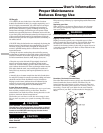
32-5037-01 3
User’s Information
Oil Supply
• If available, the use of ultra-low or low sulfur (less than
0.0015% S and 0.0015 -0.05% S, by weight, respectively), no. 2
fuel oil is highly recommended. Low sulfur fuel oil can help to
significantly reduce instances of blockage and corrosion of
the oil burner fuel delivery system, including the nozzle, the
furnace heat exchanger, and the flue gas vent system. These
benefits can appreciably decrease or eliminate service calls due
to poor fuel quality. Air pollutants emitted by the furnace as well
as the typical malodorous smell of oil combustion will also be
reduced. Consult your fuel oil supplier about the availability of
low-sulfur, fuel oil.
• DO NOT allow the fuel tank to run completely dry during the
heating season. If the fuel tank runs completely dry, it may be
necessary to purge the oil lines of trapped air. If necessary,
contact a qualified heating dealer to bleed the oil lines and
restart the burner.
• During the warmer weather, keep the tank full to prevent
condensation of moisture on the inside surface of the tank. The
presence of moisture in the tank supports the growth of biologi
cal fuel contaminants (bacteria, mold, fungus, yeast, etc.).
• Keep the cap on the fuel tank fill pipe tightly closed at all
times to prevent the entrance of moisture, foreign matter,
insects, etc. Consider adding a guard or filter to the tank vent
pipe to reduce the entrance of water and foreign matter into the
tank. Also, check the tank, vent, and fill pipe for cracks and
leaks. Have any necessary tank repairs performed as soon as
possible.
• Annually, have a bottom sample from the fuel oil tank taken
for analysis. If present in excessive quantities, sludge and water
should be removed. Fuel oil additives may be of benefit in
helping to resolve some problems that are indicated by the
analysis. In severe cases, tank cleaning may be required.
Consult your fuel oil supplier for recommendations.
A clean filter saves money.
When the furnace circulates and filters the air in your home,
dust and dirt particles build up on the filter. Excessive
accumulation can block the airflow, forcing the unit to work
harder to maintain desired temperatures.
The harder your unit has to work, the more energy it uses.
You pay more any time your system is running with a dirty
filter.
▲
CAUTION
!
BURN HAZARD - ROTATING FAN BLADES
To avoid injury from moving parts, hot surfaces, or electri-
cal shock, shut off the power to the furnace and allow the
furnace to cool BEFORE removing any furnace access
doors to service air filters.
▲
CAUTION
!
Never operate your unit for either heating or cooling with
filters removed.
Proper Maintenance
Reduces Energy Use
Help ensure top efficiency by replacing disposable filters once
a month.
Replacing your filter.
When replacing your furnace filters, always use the same
size and type as originally supplied. Filters are available
from your dealer.
▲
WARNING
!
Disconnect power to unit before removing blower door.
Highboy Furnace Filters
Highboy furnaces typically use a cleanable-type air filter
located outside the furnace cabinet. The cleanable filter may
be located in a side filter frame, mounted on the lower
outside of the furnace cabinet in the cold air return duct or in
a remotely mounted filter grill. Refer to Filter Table A for the
correct filter size.
Downflow / Horizontal Furnace Filters
Downflow/Horizontal furnaces typically use disposable filters
located outside the furnace cabinet. The filters may be
located remote to the furnace or in the return air duct near
the furnace. The filter grille could be in a hallway, wall, or in
the ceiling. Check with your dealer for the exact location,
type and size of your filter and the method of changing the
filters.










